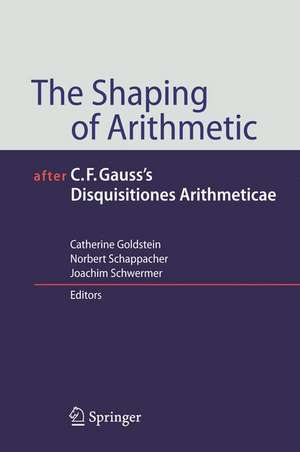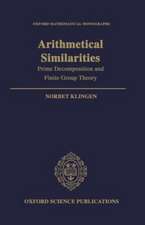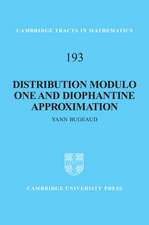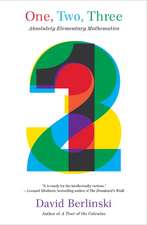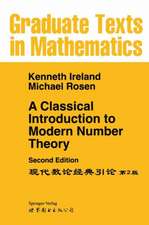The Shaping of Arithmetic after C.F. Gauss's Disquisitiones Arithmeticae
Editat de Catherine Goldstein, Norbert Schappacher, Joachim Schwermeren Limba Engleză Hardback – 9 ian 2007
| Toate formatele și edițiile | Preț | Express |
|---|---|---|
| Paperback (1) | 654.77 lei 6-8 săpt. | |
| Springer Berlin, Heidelberg – 12 feb 2010 | 654.77 lei 6-8 săpt. | |
| Hardback (1) | 665.58 lei 6-8 săpt. | |
| Springer Berlin, Heidelberg – 9 ian 2007 | 665.58 lei 6-8 săpt. |
Preț: 665.58 lei
Preț vechi: 783.04 lei
-15% Nou
Puncte Express: 998
Preț estimativ în valută:
127.36€ • 136.19$ • 106.19£
127.36€ • 136.19$ • 106.19£
Carte tipărită la comandă
Livrare economică 18 aprilie-02 mai
Preluare comenzi: 021 569.72.76
Specificații
ISBN-13: 9783540204411
ISBN-10: 3540204415
Pagini: 592
Ilustrații: XII, 578 p. 36 illus.
Dimensiuni: 155 x 235 x 37 mm
Greutate: 1.12 kg
Ediția:2007
Editura: Springer Berlin, Heidelberg
Colecția Springer
Locul publicării:Berlin, Heidelberg, Germany
ISBN-10: 3540204415
Pagini: 592
Ilustrații: XII, 578 p. 36 illus.
Dimensiuni: 155 x 235 x 37 mm
Greutate: 1.12 kg
Ediția:2007
Editura: Springer Berlin, Heidelberg
Colecția Springer
Locul publicării:Berlin, Heidelberg, Germany
Public țintă
ResearchCuprins
A Book’s History.- A Book in Search of a Discipline (1801–1860).- Several Disciplines and a Book (1860–1901).- Algebraic Equations, Quadratic Forms, Higher Congruences: Key Mathematical Techniques of the Disquisitiones Arithmeticae.- The Disquisitiones Arithmeticae and the Theory of Equations.- Composition of Binary Quadratic Forms and the Foundations of Mathematics.- Composition of Quadratic Forms: An Algebraic Perspective.- The Unpublished Section Eight: On the Way to Function Fields over a Finite Field.- The German Reception of the Disquisitiones Arithmeticae: Institutions and Ideas.- A Network of Scientific Philanthropy: Humboldt’s Relations with Number Theorists.- ‘O ??ò?’ A??????í???: The Rise of Pure Mathematics as Arithmetic with Gauss.- Complex Numbers and Complex Functions in Arithmetic.- From Reciprocity Laws to Ideal Numbers: An (Un)Known Manuscript by E.E. Kummer.- Elliptic Functions and Arithmetic.- Numbers as Model Objects of Mathematics.- The Concept of Number from Gauss to Kronecker.- On Arithmetization.- Number Theory and the Disquisitiones in France after 1850.- The Hermitian Form of Reading the Disquisitiones.- Number Theory at the Association française pour l’avancement des sciences.- Spotlighting Some Later Reactions.- An Overview on Italian Arithmetic after the Disquisitiones Arithmeticae.- Zolotarev’s Theory of Algebraic Numbers.- Gauss Goes West: The Reception of the Disquisitiones Arithmeticae in the USA.- Gauss’s Theorems in the Long Run: Three Case Studies.- Reduction Theory of Quadratic Forms: Towards Räumliche Anschauung in Minkowski’s Early Work.- Gauss Sums.- The Development of the Principal Genus Theorem.
Recenzii
From the reviews:
"A book that traces the profound effect Gauss’s masterpiece has had on mathematics over the past two centuries. … The shaping of arithmetic is a major accomplishment, one which will stand as an important reference work on the history of number theory for many years. … The editors and authors deserve our thanks for their efforts." (Victor J. Katz, Mathematical Reviews, Issue 2008 h)
“It’s a big book, with eighteen authors and almost six hundred pages, and it mixes the work of well-established scholars with that of recent Ph.D.’s. … This volume deserves a wide audience, both among the mathematically able and among historians of nineteenth-century science.” (Thomas Archibald, Institute for Science and International Security, Vol. 102 (2), June, 2011)
"A book that traces the profound effect Gauss’s masterpiece has had on mathematics over the past two centuries. … The shaping of arithmetic is a major accomplishment, one which will stand as an important reference work on the history of number theory for many years. … The editors and authors deserve our thanks for their efforts." (Victor J. Katz, Mathematical Reviews, Issue 2008 h)
“It’s a big book, with eighteen authors and almost six hundred pages, and it mixes the work of well-established scholars with that of recent Ph.D.’s. … This volume deserves a wide audience, both among the mathematically able and among historians of nineteenth-century science.” (Thomas Archibald, Institute for Science and International Security, Vol. 102 (2), June, 2011)
Notă biografică
Catherine Goldstein is Directrice de recherches du CNRS and works at the Institut de mathématiques de Jussieu (Paris, France). She is the author of "Un théorème de Fermat et ses lecteurs" (1995) and a coeditor of "Mathematical Europe: History, Myth, Identity"(1996). Her research aims at developing a social history of mathematical practices and results, combining close readings and a network analysis of texts. Her current projects include the study of mathematical sciences through World War I and of experimentation in XVII th-century number theory.
Norbert Schappacher is professor of mathematics at Université Louis Pasteur, Strasbourg.His mathematical interests relate to the arithmetic of elliptic curves.But his current research projects lie in the history of mathematics. Specifically, he focuses on the intertwinement of philosophical and political categories with major junctures in the development of mathematical disciplines in the XIX\up{th} and XX\up{th} centuries. Examples include number theory and algebraic geometry, but also medical statistics.
Joachim Schwermer is professor of mathematics at University of Vienna. In addition, he serves as scientific director at the Erwin-Schroedinger International Institute for Mathematical Physics, Vienna. His research interests lie in number theory and algebra, in particular, in questions arising in arithmetic algebraic geometry and the theory of automorphic forms. He takes a keen interest in the mathematical sciences in the XIX\up{th} and XX\up{th} centuries in their historical context.
Norbert Schappacher is professor of mathematics at Université Louis Pasteur, Strasbourg.His mathematical interests relate to the arithmetic of elliptic curves.But his current research projects lie in the history of mathematics. Specifically, he focuses on the intertwinement of philosophical and political categories with major junctures in the development of mathematical disciplines in the XIX\up{th} and XX\up{th} centuries. Examples include number theory and algebraic geometry, but also medical statistics.
Joachim Schwermer is professor of mathematics at University of Vienna. In addition, he serves as scientific director at the Erwin-Schroedinger International Institute for Mathematical Physics, Vienna. His research interests lie in number theory and algebra, in particular, in questions arising in arithmetic algebraic geometry and the theory of automorphic forms. He takes a keen interest in the mathematical sciences in the XIX\up{th} and XX\up{th} centuries in their historical context.
